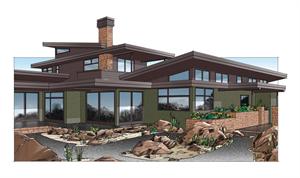03 Feb LBC – the Most Stringent Green Building Standard
This article from EcoHome highlights some of the challenges that our Desert Rain team faces in designing, sourcing, and eventually building this ultra green home in Bend.
Living Buildings
By: Rick Schwolsky

DESERT RAIN HOUSE "You have to question every building practice you thought was standard," says ML Vidas, sustainability advisor on this new Living Building Challenge project under way in Bend, Ore. Designer Al Tozer calls this the most rigorous process hes experienced, from ensuring net zeroenergy and water performance to product selection and local sourcing. "Specifying materials is a real challenge," he says. "They're pretty strict about the LBC Red List." Exterior features include: Walk-off grates; FSC-certified and reclaimed wood products; R-60 closed-cell foam walls/ceilings; Loewen high-performance windows; passive solar design; Solar PV and water heating; rainwater harvesting; local sandalwood stone veneer; and constructed wetland Credit: Harry Whitver
When the Cascadia Green Building Council launched its Living Building Challenge (LBC) program in 2006, its certification requirements were unofficially billed as “beyond LEED.” Today, as its first projects are being certified, LBC is considered by many in green building circles to be the most stringent standard in North America.
The program’s seven performance “Petals”—Site, Water, Energy, Health, Materials, Equity, and Beauty—are subdivided into 20 “Imperatives” that guide LBC teams and drive the program’s philosophy and ambitious goals. And while other rating systems merge prerequisites with optional credits for things like “net-zero energy,” “proximity to mass transit,” and “indoor air quality,” all of LBC’s Imperatives are mandatory for full certification. Some, like “embodied carbon footprint” and “appropriate sourcing,” challenge even the most experienced designers, and the “net-zero water” requirement places them in conflict with many existing codes. In addition, buildings must be operational for at least 12 months prior to LBC certification, exceeding all other programs that base their standards on modeled performance.
But perhaps the toughest requirement deals with selecting products, which must meet the evolving Red List Imperative that lays out 14 materials or chemicals restricted from LBC projects. This imperative is so tough—listing ingredients like phthalates, PVC, and added formaldehyde, among others—LBC will grant temporary exemptions so teams can proceed with their projects, but requires those teams to advocate with manufacturers and educate them in support of the Red List ideals.
“The Challenge is unique,” says Eden Brukman, vice president of the International Living Building Institute. “We integrate philosophy, advocacy, and certification into one standard.” —Rick Schwolsky



